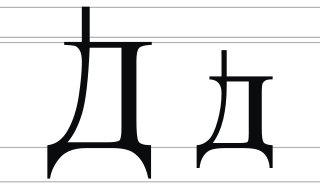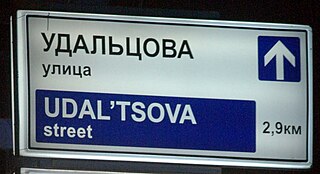
The Cyrillic script, Slavonic script or simply Slavic script is a writing system used for various languages across Eurasia. It is the designated national script in various Slavic, Turkic, Mongolic, Uralic, Caucasian and Iranic-speaking countries in Southeastern Europe, Eastern Europe, the Caucasus, Central Asia, North Asia, and East Asia, and used by many other minority languages.
Transliteration is a type of conversion of a text from one script to another that involves swapping letters in predictable ways, such as Greek ⟨α⟩ → ⟨a⟩, Cyrillic ⟨д⟩ → ⟨d⟩, Greek ⟨χ⟩ → the digraph ⟨ch⟩, Armenian ⟨ն⟩ → ⟨n⟩ or Latin ⟨æ⟩ → ⟨ae⟩.

In linguistics, romanization is the conversion of text from a different writing system to the Roman (Latin) script, or a system for doing so. Methods of romanization include transliteration, for representing written text, and transcription, for representing the spoken word, and combinations of both. Transcription methods can be subdivided into phonemic transcription, which records the phonemes or units of semantic meaning in speech, and more strict phonetic transcription, which records speech sounds with precision.
A caron is a diacritic mark commonly placed over certain letters in the orthography of some languages to indicate a change of the related letter's pronunciation.
Phonetic transcription is the visual representation of speech sounds by means of symbols. The most common type of phonetic transcription uses a phonetic alphabet, such as the International Phonetic Alphabet.

Cyrillization or Cyrillisation is the process of rendering words of a language that normally uses a writing system other than Cyrillic script into the Cyrillic alphabet. Although such a process has often been carried out in an ad hoc fashion, the term "cyrillization" usually refers to a consistent system applied, for example, to transcribe names of German, Chinese, or English people and places for use in Russian, Ukrainian, Serbian, Macedonian or Bulgarian newspapers and books. Cyrillization is analogous to romanization, when words from a non-Latin script-using language are rendered in the Latin alphabet for use
Polivanov system is a system of transliterating the Japanese language into Russian Cyrillic script, either to represent Japanese proper names or terms in Russian or as an aid to Japanese language learning in those languages. The system was developed by Yevgeny Polivanov in 1917.

Yevgeny Dmitrievich Polivanov was a Soviet linguist, orientalist and polyglot who wrote major works on the Chinese, Japanese, Uzbek and Dungan languages and on theoretical linguistics and poetics.

The Bulgarian Cyrillic alphabet is used to write the Bulgarian language. The Cyrillic alphabet was originally developed in the First Bulgarian Empire during the 9th – 10th century AD at the Preslav Literary School.

The romanization of the Russian language, aside from its primary use for including Russian names and words in text written in a Latin alphabet, is also essential for computer users to input Russian text who either do not have a keyboard or word processor set up for inputting Cyrillic, or else are not capable of typing rapidly using a native Russian keyboard layout (JCUKEN). In the latter case, they would type using a system of transliteration fitted for their keyboard layout, such as for English QWERTY keyboards, and then use an automated tool to convert the text into Cyrillic.

The soft sign is a letter in the Cyrillic script that is used in various Slavic languages. In Old Church Slavonic, it represented a short or reduced front vowel. However, over time, the specific vowel sound it denoted was largely eliminated and merged with other vowel sounds.
The romanization of Ukrainian, or Latinization of Ukrainian, is the representation of the Ukrainian language in Latin letters. Ukrainian is natively written in its own Ukrainian alphabet, which is based on the Cyrillic script. Romanization may be employed to represent Ukrainian text or pronunciation for non-Ukrainian readers, on computer systems that cannot reproduce Cyrillic characters, or for typists who are not familiar with the Ukrainian keyboard layout. Methods of romanization include transliteration and transcription.

Romanization of Bulgarian is the practice of transliteration of text in Bulgarian from its conventional Cyrillic orthography into the Latin alphabet. Romanization can be used for various purposes, such as rendering of proper names and place names in foreign-language contexts, or for informal writing of Bulgarian in environments where Cyrillic is not easily available. Official use of romanization by Bulgarian authorities is found, for instance, in identity documents and in road signage. Several different standards of transliteration exist, one of which was chosen and made mandatory for common use by the Bulgarian authorities in a law of 2009.

The Ukrainian Latin alphabet is the form of the Latin script used for writing, transliteration and retransliteration of Ukrainian.

The Kontsevich system is a Cyrillization system for the Korean language and currently the main system of transcribing and transliterating Korean words into the Cyrillic alphabet. The Kontsevich system was created by the Soviet-Russian scholar Lev Kontsevich in the 1950s based on the earlier transliteration system designed by Aleksandr Kholodovich.
The cyrillization of Chinese is the transcription of Chinese characters into the Cyrillic alphabet.
The romanization of Japanese is the use of Latin script to write the Japanese language. This method of writing is sometimes referred to in Japanese as rōmaji.

Yo, Jo or Io is a letter of the Cyrillic script. In Unicode, the letter ⟨Ё⟩ is named CYRILLIC CAPITAL/SMALL LETTER IO.
In contemporary Japanese writing, foreign-language loanwords and foreign names are normally written in the katakana script, which is one component of the Japanese writing system. As far as possible, sounds in the source language are matched to the nearest sounds in the Japanese language, and the result is transcribed using standard katakana characters, each of which represents one syllable. For example, America is written アメリカ (A-me-ri-ka). To accommodate various foreign-language sounds not present in Japanese, a system of extended katakana has also developed to augment standard katakana.
Orthographic transcription is a transcription method that employs the standard spelling system of each target language.











